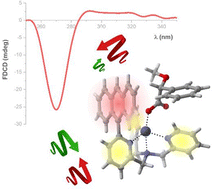Fluorescence detected circular dichroism (FDCD) of a stereodynamic probe†
Abstract
The use of chiroptical techniques in combination with stereodynamic probes is becoming one of the leading strategies for chiral sensing. While in most of the reported studies circular dichroism (CD) is the adopted spectroscopic technique, examples regarding the use of vibrational CD (VCD), circularly polarized luminescence (CPL), and Raman optical activity (ROA) are emerging as innovative tools. In this communication, an anthracene-decorated tris(2-pyridylmethyl)amine zinc complex (TPMA) is reported for its capability to act as a chiral sensor using either CD or fluorescence detected circular dichroism (FDCD). The latter technique offers the unique possibility to determine the enantiomeric excess of a series of carboxylic acids at sensor concentrations down to 0.1 μM. Limitations and possibilities opened by the use of this methodology, in particular regarding the specificity of the probe in the presence of another contaminant, are discussed.



 Please wait while we load your content...
Please wait while we load your content...